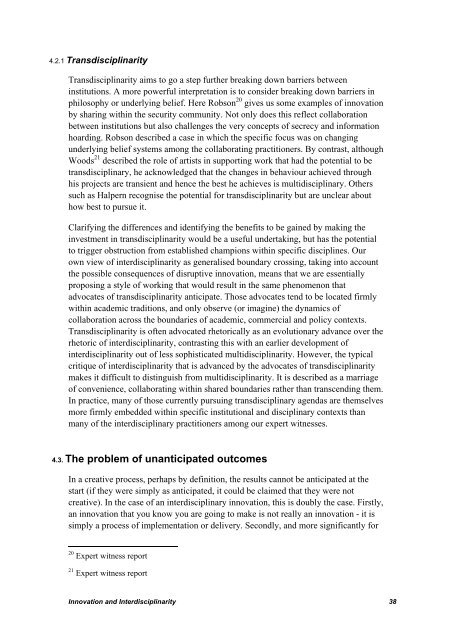Radical innovation: crossing knowledge boundaries with ...
Radical innovation: crossing knowledge boundaries with ...
Radical innovation: crossing knowledge boundaries with ...
You also want an ePaper? Increase the reach of your titles
YUMPU automatically turns print PDFs into web optimized ePapers that Google loves.
4.2.1 Transdisciplinarity<br />
Transdisciplinarity aims to go a step further breaking down barriers between<br />
institutions. A more powerful interpretation is to consider breaking down barriers in<br />
philosophy or underlying belief. Here Robson 20 gives us some examples of <strong>innovation</strong><br />
by sharing <strong>with</strong>in the security community. Not only does this reflect collaboration<br />
between institutions but also challenges the very concepts of secrecy and information<br />
hoarding. Robson described a case in which the specific focus was on changing<br />
underlying belief systems among the collaborating practitioners. By contrast, although<br />
Woods 21 described the role of artists in supporting work that had the potential to be<br />
transdisciplinary, he ac<strong>knowledge</strong>d that the changes in behaviour achieved through<br />
his projects are transient and hence the best he achieves is multidisciplinary. Others<br />
such as Halpern recognise the potential for transdisciplinarity but are unclear about<br />
how best to pursue it.<br />
Clarifying the differences and identifying the benefits to be gained by making the<br />
investment in transdisciplinarity would be a useful undertaking, but has the potential<br />
to trigger obstruction from established champions <strong>with</strong>in specific disciplines. Our<br />
own view of interdisciplinarity as generalised boundary <strong>crossing</strong>, taking into account<br />
the possible consequences of disruptive <strong>innovation</strong>, means that we are essentially<br />
proposing a style of working that would result in the same phenomenon that<br />
advocates of transdisciplinarity anticipate. Those advocates tend to be located firmly<br />
<strong>with</strong>in academic traditions, and only observe (or imagine) the dynamics of<br />
collaboration across the <strong>boundaries</strong> of academic, commercial and policy contexts.<br />
Transdisciplinarity is often advocated rhetorically as an evolutionary advance over the<br />
rhetoric of interdisciplinarity, contrasting this <strong>with</strong> an earlier development of<br />
interdisciplinarity out of less sophisticated multidisciplinarity. However, the typical<br />
critique of interdisciplinarity that is advanced by the advocates of transdisciplinarity<br />
makes it difficult to distinguish from multidisciplinarity. It is described as a marriage<br />
of convenience, collaborating <strong>with</strong>in shared <strong>boundaries</strong> rather than transcending them.<br />
In practice, many of those currently pursuing transdisciplinary agendas are themselves<br />
more firmly embedded <strong>with</strong>in specific institutional and disciplinary contexts than<br />
many of the interdisciplinary practitioners among our expert witnesses.<br />
4.3. The problem of unanticipated outcomes<br />
In a creative process, perhaps by definition, the results cannot be anticipated at the<br />
start (if they were simply as anticipated, it could be claimed that they were not<br />
creative). In the case of an interdisciplinary <strong>innovation</strong>, this is doubly the case. Firstly,<br />
an <strong>innovation</strong> that you know you are going to make is not really an <strong>innovation</strong> - it is<br />
simply a process of implementation or delivery. Secondly, and more significantly for<br />
20 Expert witness report<br />
21 Expert witness report<br />
Innovation and Interdisciplinarity 38

















